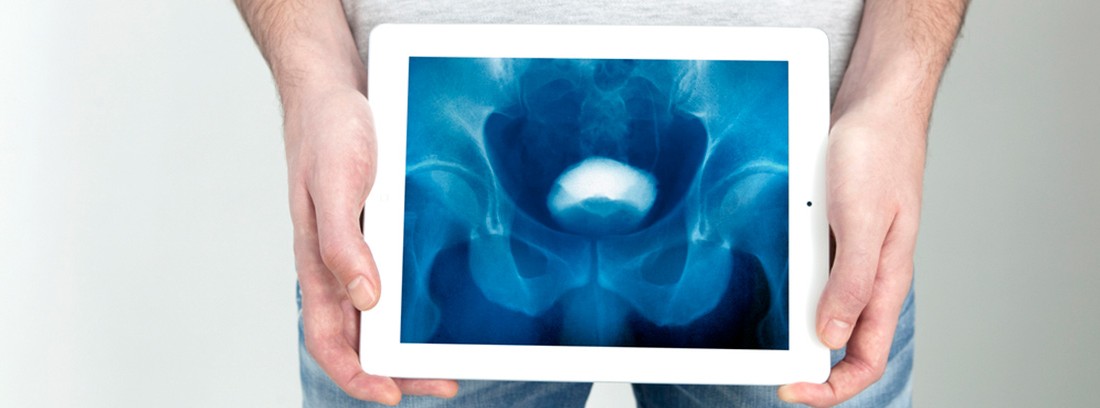Urography

The urography It always requires the use of a contrast, depending on the route used to administer the contrast, the study can receive different names:
- Intravenous Urography - Contrast is given using a vein in the arm
- Retrograde Urography: Contrast is administered directly to the ureter using a catheter inserted through the urinary urethra.
- Antegrade urography: contrast is injected under ultrasound control directly into the renal pelvis
The use of one or another route of administration of the contrast will depend on the reasons for which the study is carried out.
How is the study done?
The urographic study is performed in the radiology room of the medical center or hospital by a radiology technician. The patient must undress the anatomical area under study and a gown will be provided to cover himself; at the same time you should remove your personal items, especially jewelry and metal objects that can interfere with radiological images.
The patient must urinate immediately before starting the study to empty the urinary bladder. Initially, a plain X-ray of both kidneys, urinary tract, and bladder will be performed. Subsequently, the patient will lie down on a stretcher during the study for the administration of contrast. Once the contrast reaches the kidney and / or the urinary tract, several serial radiographs of the kidney and urinary tract are performed to study the behavior of the contrast and its elimination. The study concludes with a final X-ray performed after a new urination and bladder emptying.
The number of radiographs performed will vary depending on the reasons for which the study is performed and the findings found during the study. The entire duration of the study can take between 30-60 minutes.
Preparation for the study
Before the study, the signing of an informed consent by the patient will be requested.
For a correct visualization of the radiological images it is necessary to clean the digestive tract; For this, the patient must follow a specific diet and use an over-the-counter evacuating solution in pharmacies. In general, the patient should follow the following recommendations:
- Two days prior to the study, the patient must start a diet low in residues (fiber), avoiding taking potatoes, vegetables or fruits.
- The night before the test, you can only drink liquids.
- Between 10 and 15 hours prior to the study, the patient should take an evacuating solution following the recommendations of the package insert; previously, you should avoid taking any solid food 4 hours before the start of taking the solution.
- Sometimes, if a correct cleaning is not achieved with the use of the evacuating solution (elimination of clear liquid rectally) it will be necessary to use cleaning enemas following the instructions in the package, until a correct cleaning of the digestive tract is achieved.
- The patient can take his usual medication during the preparation for the study unless contraindicated.
On the day of the examination, the patient cannot eat solid food; he can have sugary tea or coffee for breakfast.
The patient can lead a normal life at the end of the study. The intake of abundant fluids is recommended to promote a rapid elimination of the contrast.
What does it feel like during and after the study?
The study is painless for the patient except for the discomfort of preparing for the exam and administering the contrast (body heat, bad taste in the mouth ...)
In some cases, an allergic reaction to the contrast may occur, in the case of presenting a skin rash, itching or respiratory distress during the study, it should be indicated to the radiology technician immediately.
Study risks
The urographic study, in general, does not imply a significant risk to health.
The type of radiation as well as the dose used follows strict safety controls and in general the benefit obtained outweighs the minimal risks of the radiation itself.
The embryo, fetus, and children are more susceptible to radiation, so in these cases unnecessary studies should be avoided. A pregnant or suspected pregnant woman (including those with an IUD) should avoid the study as much as possible and should tell the radiology technician that she is pregnant before having an X-ray.
The patient may present intolerance / allergy to the evacuating solution, and / or allergy to the contrast used during the study. Severe anaphylactic reaction is rare.
Study contraindications
The patient should consult with his doctor before carrying out the study in case of:
- Pregnancy and breastfeeding.
- Renal insufficiency
- allergy to the stool solution
- Contrast allergy
- Take some kind of medication.
What is the study done for?
Urography is a widely known and widely used diagnostic test in the field of Urology. It is especially useful for the diagnosis and monitoring of urinary flow disorders such as vesic-renal reflux or obstructive uropathy; at the same time it allows the suspected diagnosis of multiple infectious, inflammatory and / or tumor type pathologies of the kidney and urinary tract that must be confirmed later with specific studies.
As it is a complex technique, not exempt from eventual risks, it is usually reserved for very precise indications.
Family and Community Medicine Specialist
(Updated at Apr 14 / 2024)